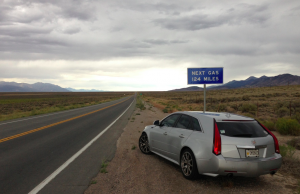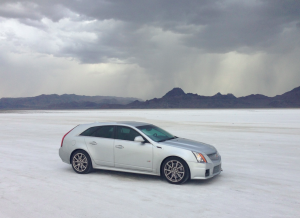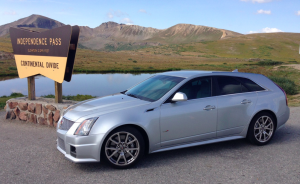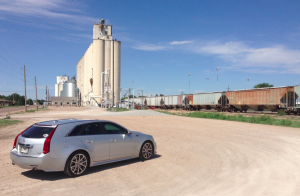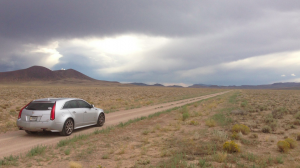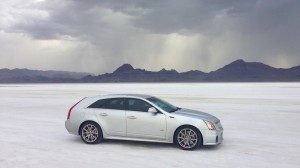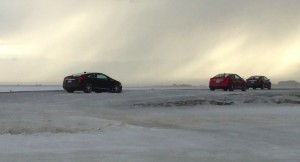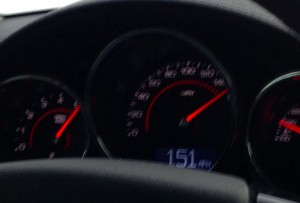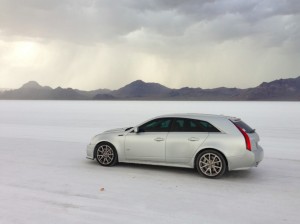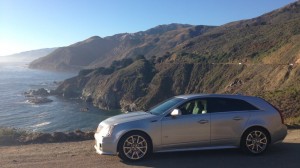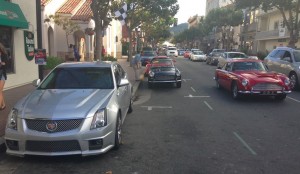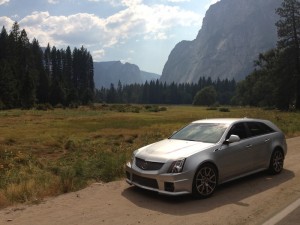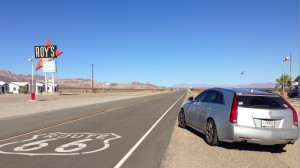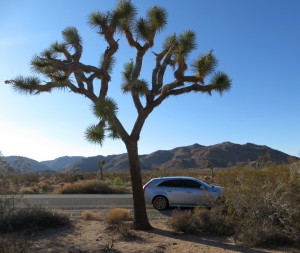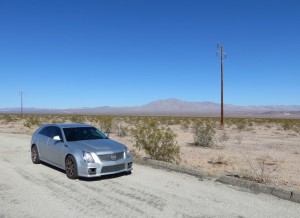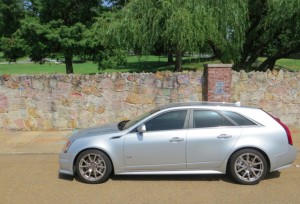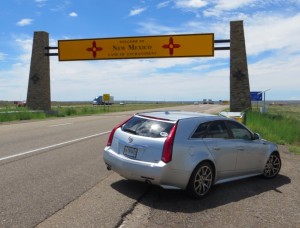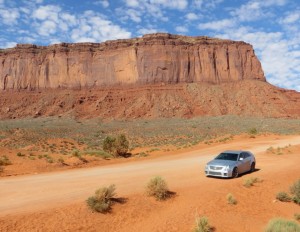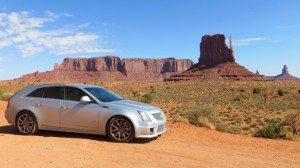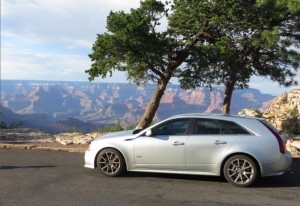We Made It: Recapping 6,300 Miles and 17 States in a CTS-V Wagon
Posted by Doug DeMuro in V Wagon Roadtrip! on | 8 comments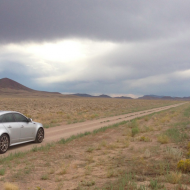
I’m writing today from my desk. In my home. With my lamps, and my couch, and my fuzzy purple blankets, which sound really tacky but go surprisingly well with the room.
This is a big deal. Really, it is. It’s a major departure from my last few submissions, which were all written the same way: hoisting my laptop above my head in a hotel room closet so I could reach the eleven square inches covered by the wireless Internet.
In other words: I’ve made it through the roadtrip alive.
“What roadtrip?” you ask, pretending that you did not see – and ignore – my last few posts about how I drove my Cadillac CTS-V Wagon across the entirety of the United States in order to sit in traffic at Monterey Car Week. Yes, that roadtrip. Now it’s over.
But before you can bid my V-Wagon roadtrip farewell and concentrate on reading something informative written by Travis (hah!), I’ve decided to write one last post summing up a few highlights of driving across the country – and back – in a 556-horsepower Cadillac with taillights the size of small children. Here goes.
Fuel By the Numbers
Everyone wants to know about fuel. Seriously, everyone. I know this because I get tweets and text messages and e-mails from people all over the country – all over the world – that say: How much fuel are you using? I have no idea why this is, because they already know the answer, which can be defined technically as “a lot.”
But to satisfy your curiosity, I’ll define it even more technically here. We drove 6,285 miles, which – for you metric Jalopnik users – is roughly 10,000 kilometers. In that time, we used 356.151 gallons of fuel, which – again converted for the metric folks – is about 87 kilopascals. This translates to 17.65 miles per gallon, or approximately 27 liters per sixpence.
Now, I know what you’re thinking. You’re thinking: Couldn’t you just type the conversions into Google rather than make up things like “liters per sixpence?” And unfortunately, the answer is no.
You may also be thinking: That sounds expensive! And, yes, it was. We paid an average of $4.05 per gallon, which means we spent a total of $1,440.85 on fuel. The car never made it more than 300 miles between fuel stops, hitting that number only once: from Salina, Kansas, to Columbia, Missouri.
The most expensive gas was in Big Sur, California, where a poorly-timed fuel stop meant I had to pay six bucks a gallon… for regular. The cheapest fuel was $3.52 per gallon in Yukon, Oklahoma, proving that gas prices directly correspond to an area’s desirability. (Do you hear that? That’s the sound of everyone in Yukon, Oklahoma, collectively boycotting my book.)
Top Speed
A few people have accused me of light-footing it, despite the fact that I just ended a 6,300-mile trip with a fuel economy average below 18 miles per gallon. I’m curious about these people. Do you believe the interstate highway system is a playground, where you just do burnouts and triple-digit speeds all the time? (These people are thinking: Uh… yeah. Duh?)
The truth is this: when you’re on a 6,300-mile roadtrip, you pace yourself. What I mean is, you have fun for the first hour or two, then you set your cruise control 10 over the speed limit and angrily curse every time a truck going 62 miles per hour pulls out in front of you so it can pass a truck going 61 miles per hour.
With that said, I did open it up a few times. I got above 150 miles per hour on the Bonneville Salt Flats, and my girlfriend had her first triple-digit experience there, too. And there may have been an incident in Kansas where a guy in a 535xi learned the silver station wagon doing 84 in a 75 zone shouldn’t be underestimated.
Aside from that, I kept things pretty reasonable. We drove through 17 different states and approximately seven million rural counties, all of which are hungry for revenue from out-of-staters driving expensive luxury cars. I wasn’t stopped once, though I was briefly yelled at by a police officer in Pebble Beach who mistakenly thought “directing traffic for a car show” would be a stress-free way to earn some overtime pay.
Best Places
Now that I’ve seen the entire country, minus the parts that don’t matter, such as Delaware, many people have asked me what I enjoyed the most. The true answer to this question is, of course, Monterey Car Week, but I can’t say that without sounding like a car-obsessed freak who drove 6,300 miles to look at some Ferraris.
So instead I will give a more diplomatic answer, which is that the diversity and vastness of the United States was a welcome and enjoyable delight on our splendid vacation. This covers up the fact that the best part of the trip, aside from car week, was seeing the “Welcome to Georgia” sign and knowing that, in a few hours, I would be wrapped up in my purple blankets watching Pawn Stars.
OK, fine, I have an actual answer to this question. The Grand Canyon was the most beautiful thing we saw. A close second was Monument Valley, followed by Big Sur and the Rocky Mountains. We enjoyed the Great Salt Lake (we waded in) and the Salt Flats. And I was pleasantly surprised by the desert in both Southern California and Nevada, where you can stop the car in the road, walk around for a while, and take in what has to be the most vast, empty land in the United States. Yosemite was a slight disappointment, largely because it smelled like an airport smoker’s lounge the entire time we were there.
We also loved the cities we spent time in: Laguna Beach, Aspen, and Monterey. Honorable mention goes to St. Louis, which is a surprisingly nice place considering most people I know who grew up there get down whenever they hear a loud popping noise.
And the Car?
Oh, yes. The car.
Well, the car made it back in one piece. Mostly. The brakes feel like I’m driving over a rough pavement test course every time I try to slow down. They did for the entire trip. This is especially disappointing because I took it in a few days before I left, and not a word was said about brake wear.
The right rear tire is still leaking air. This is the second right rear tire that’s been leaking, which suggests that maybe I didn’t need to replace the first one. The car needs an oil change. And the plastic mounts that protect the lower part of the front bumper are hanging loose. It’s at the dealer right now for the fourth time since I bought it less than 60 days ago.
Of course, there’s a benefit to all this, namely that for the next few days I’ll be driving the world’s fastest Cadillac SRX.
Overall
This trip was a blast, and I highly encourage anyone considering a roadtrip to get out there, see the country, and have fun. Just remember that all this enjoyment may cost a few cubic centimeters of money. And for God’s sake, don’t stop in Big Sur for fuel.
Click here to see a really cool photo album of the car parked in front of things.
V Wagon Roadtrip: The Bonneville Salt Flats Are Awesome
Posted by Doug DeMuro in V Wagon Roadtrip! on | 3 comments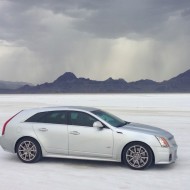
What do you know about the Bonneville Salt Flats? If you’re like me, you probably think it’s an empty, salty place where crazy people drive rocket-powered vehicles at speeds normally reserved for passenger jets. Or maybe you know of it from that Anthony Hopkins movie. You know the one: he travels all the way from New Zealand with his rickety old motorcycle only to discover they don’t have his paperwork, and he’s only allowed to race in a rented Ford Escape.
Well, I’ve recently learned something else about the Bonneville Salt Flats: they’re a lot of fun.
Before we get to that, a little background. As you know, I’m taking my CTS-V Wagon on a long roadtrip from Atlanta to California and back with my girlfriend. We’re now in the “and back” stretch, meaning we hit Monterey Car Week, Yosemite National Park, the emptiness that is Nevada (State motto: Watch for cattle on roads!). You’d know all this if you followed me on Twitter, which I highly suggest because I sometimes take some cool pictures of the V Wagon in front of stuff.
Anyway: while the quickest route back from California would’ve been through the southern half of the country, I wanted to return via Colorado to see family. That meant driving through Utah, a state of immense natural beauty and something like five different national parks dedicated to bizarre rock formations. Well, we skipped all of that. Instead, we went to the Bonneville Salt Flats.
For those who haven’t heard of the Salt Flats, here are the basics:
1. There’s a lot of salt.
2. It’s very flat.
Any other information, such as history, is largely unnecessary, primarily because most articles on the topic use boring terms like “Pleistocene” and “prehistoric pluvial lake.” My own theory on its history is quite different: I believe the flats were created when dinosaurs poured large shakers of sale over an empty field so they could go sledding. (DeMuro et al., 2013)
Anyway: we arrived at the flats in the evening. For those who think it’s a place where you have to buy tickets, or stand in line, or hop fences, you’re wrong. That’s only during Speed Week. When no one is there, the road to the flats simply ends and there’s a soft grade down to the salt. Anyone can get on, at any time, in any vehicle.
As we drove on to the flats, I had just one goal in mind: don’t crash. I wasn’t sure I wanted to do anything more than that for many reasons, like the fact that we still had to drive the car across the country; the fact that I’ve already driven at high speeds on the autobahn; and most importantly, the fact that the area is so desolate you get the feeling the local doctor is also the mayor, the sheriff, and the guy who runs the fillin’ station.
So we set out on to the flats cautiously, driving at normal speeds and getting used to the terrain. But while I planned to go slowly, I was quickly egged on by the only other group on the flats: Cadillac. It seems Cadillac was there to test pre-production ELRs, which made me feel a little safer. After all, if General Motors engineers thought this was OK, how bad could it be?
Within minutes of our arrival, the Cadillac crew departed the flats, likely done for the day. Even though they were about 40 feet from my car – and I was the only other person around for miles – they never even glanced at me. Ahh, Cadillac pride.
With the Cadillac crew gone, we made our way a few hundred feet to the “track” that was marked with cones. Speed Week was just a few days ago, which meant the salt was perfectly smoothed and the lanes were easily discernible. So I lined up at the first cone, pushed the accelerator to the floor and … spun my tires.
It turns out driving on the salt is best done from a gentle roll, or else you’ll have trouble getting traction. So I lined up again, pushed the accelerator lightly, and began my first run. Egged on by my girlfriend, I reached 130 miles per hour … while driving on salt.
With no one around and a little daylight left, I decided to try again… then again. The flats have this effect. You think “I can do a little better!” and the next thing you know, you’ve been out there six hours and there’s enough salt on your car to de-ice metro Detroit for an entire winter.
But we didn’t have this problem, largely because it started pouring after my third run. Rain and the flats don’t mix, it seems, and while the government looks the other way if you drive fast in Bonneville, it strongly encourages you to leave quickly if it begins raining. Fortunately, we took this photo about five minutes before the deluge:
After departing the flats, we drove back to nearby West Wendover, Nevada, a town that has roughly the same number of casinos as residents. While the rain took most of the salt off the Wagon, we gave it a thorough car wash – including a heavy underbody spray – and went to dinner.
Climbing into bed that night, the adrenalin was still pumping from hitting 151 miles per hour – as legally as possible – in the United States. It may seem like you’re just driving in a straight line, but Bonneville is a lot of fun. You don’t even need a CTS-V Wagon to enjoy it. All you need is a smooth stretch of salt, a sense of adventure, and a nearby car wash.
This story was originally posted on Jalopnik.
V Wagon Roadtrip: After 3500 Miles, How’s It Holding Up?
Posted by Doug DeMuro in V Wagon Roadtrip! on | 9 comments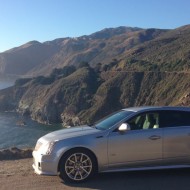
We put roadtrip mile number 3,500 on the V Wagon in Yosemite National Park today. Three thousand five hundred miles. In ten days. Maybe this number seems reasonable to you. Maybe it doesn’t sound so bad. Maybe it sounds like child’s play. If that’s the case, maybe you’re a long-haul trucker, or possibly an astronaut.
It’s an enormous figure to me, largely because my usual commute spans the distance from my bedroom to my living room. (This joke is told every single time a group of auto journalists assembles in one place, even though no one has laughed at it since roughly 1973.)
As 3,500 miles is a lot of driving in a week and a half, I keep receiving the following question: How’s the car holding up? I was asked this at Pebble by people I didn’t know. And the answer is … well, let’s examine that in detail.
We’ll start in front, home to the headlights, the grille, and the 556-horsepower V8 that’s tuned to sound like a small 6-cylinder, or maybe a window-mounted air conditioner. All of that stuff is fine.
The front bumper isn’t quite so lucky: two small black plastic pieces meant to protect the lower bumper from scratches have come loose. But the prognosis is good. It looks like they can be reattached by someone with greater mechanical knowledge than me, a group that’s defined as anyone whose abilities extend beyond a) plugging in the iPhone before bed, and b) unplugging the iPhone in the morning.
The brakes won’t be so easy to fix. Despite visiting my dealership four days before I left and announcing I would be driving the car 5,500 miles in the next three weeks, I discovered the brakes needed replacement about nine hours after I left. I’m pretty sure the rotors are warped, because stopping at high speeds feels like driving over fallen logs approximately 19 feet in diameter.
The last nuisance is the passenger-side rear tire, which was the reason for my dealer visit before the trip. The old passenger-side rear tire was losing air, and the dealer said it had a small leak. So I paid $470 to put on a new tire, which is now leaking too. Some coincidence, wouldn’t you say?
At this point, maybe you think I’m complaining. You might think: DeMuro, you think you have tire problems? Come to my place and we’ll do burnouts until you’re driving on the rims!
But really, I’m not complaining at all. Driving 3,500 miles in 10 days, I expected more issues. In reality, the car only has three problems: one minor (the plastic bumper pieces) and two that should’ve been solved before we left. Other than those, it still starts, runs, drives, turns, and accelerates just as it did when we left. The only real difference is the interior smell. You can imagine.
As for the trip itself: if you’ve been following my updates on Twitter (and you should be), you’ll know we’ve already started making our way back across the country. Since I wrote last, we hit LA, Santa Barbara, the beautiful California Highway 1 along the Central Coast, and, of course, Monterey Car Week. Yesterday was Yosemite, and today begins the long trek through the Nevada desert.
Unfortunately, the shorter distances and frequent stops have taken a toll on the V Wagon’s gas mileage. During Monterey Car Week, I averaged – this is entirely true – 11.22 miles per gallon. If you’re thinking that’s because I did burnouts up and down Ocean Avenue in Carmel, you’re mistaken. I wish I had done burnouts. But that wasn’t possible for the same reason the gas mileage was so low: traffic.
For those of you who have never been to Monterey Car Week, you see photos of shiny vintage cars and exciting unveilings and you probably think: This must be so cool! The reality is much different. Yes, there are shiny vintage cars. And yes, there are exciting unveilings. But that stuff is mostly forgotten because you spend half your time sitting behind rented minivans in traffic that’s so bad you might think you’re in New York City during a transit strike. Seriously: at some point, we spent 30 minutes on one four-mile section of 17-Mile Drive in Pebble Beach. That’s an average of eight miles per hour for those of you who aren’t so quick, such as the people who installed my tire.
But the gas mileage should increase in the next few days, as we have some longer distances to cover. To that end, I’m eager to get back on the road. But first, I have to go fill up my tire.
This story originally appeared on Jalopnik.
Across America In A CTS-V Wagon: Through The Desert
Posted by Doug DeMuro in V Wagon Roadtrip! on | 0 comments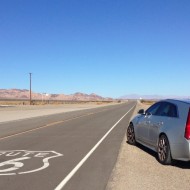
When I last provided an update on my cross-country V Wagon roadtrip, I was at the Grand Canyon. Since then, I’ve driven through the desert. If you thought these things were one and the same, as I did, you’re mistaken. It turns out the Grand Canyon is surrounded by pine trees and gas stations that charge over five dollars for premium, while the desert is surrounded by nothingness and gas stations that went out of business in the 1970s.
But let’s back up. Upon leaving the Grand Canyon, we drove towards California, where a man at the border stopped us and confiscated a large portion of our roadtrip snacks. I’m not kidding. It started when we left Arizona and saw a few signs that indicated that we would have to stop at a “checkpoint.”
Naturally, at this point, we felt we’d be in the clear because we had no drugs, or guns, or any sort of Republican paraphernalia, all of which is presumably outlawed in California. But it turns out that he was looking for fruit, so he told us to lower our window and he would do a visual inspection to see if we had any.
The problem is that we did have fruit, purchased earlier in the week at Trader Joe’s. So the inspector picked up a bag of apples, examined it carefully, and stated – in a tone I might reserve for informing someone that their home just burned to the ground and they’ve lost all their earthly possessions and possibly their pets – “These are not California apples.”
Meanwhile, as the man examined our apples, the second guy at the checkpoint, keen to avoid a backup, started waving through cars without stopping them. So we’re sitting there, temporarily detained for possession of suspect foreign apples, while these people – who could be smuggling all sorts of fruit into California from exotic, disease-ridden places such as Nevada – are driving right past without so much as slowing down.
In the end, our fruit violation was deemed so grievous that the man confiscated our apples – all four of them – and wrote down my license plate number. Truly. I assume we are now on the California State Fruit Watch List, and we will be periodically stopped throughout our time in California by the CHP, who will search our vehicle for pears.
After we left the fruit checkpoint, we drove through the desert. When I say this, I don’t mean we took the interstate through the desert. I mean we got on some desolate two-lane highway – the kind of highway where you can stop the car in the middle of the road for as long as you’d like, including overnight – and drove towards Joshua Tree National Park, where I insisted we visit because I had spent eighty bucks on an unlimited national parks pass, and I’ll be damned if I wasn’t going to get my money’s worth.
For those who haven’t been to the Mojave Desert, I’ll attempt to sum it up. Imagine, if you will, absolutely nothing. Now triple it. Then add some mountains. This is an exact description of California from approximately the Arizona border to Greater Los Angeles.
OK, so maybe it isn’t that bad. There are two or three towns along this two-lane highway, all of which include about four mobile homes and a collection of broken-down vehicles that are probably advertised on Craigslist as “ran when parked.” There’s also the town of Amboy, home of Roy’s Motel and Cafe, a former Route 66 hotspot that’s now largely abandoned. As we stood at Roy’s, photographing its iconic sign, surrounded by almost incomprehensible nothingness, a Maserati GranTurismo drove by.
Eventually, we continued our drive and passed more nothing, then still more nothing. The only way I can describe this accurately is to say that we pulled over at one point, and by this I mean we stopped in the middle of the highway, and when we got out to look around we realized it was absolutely silent. Imagine it: no cars, no birds, no construction vehicles, no horns, no screaming children. Pure and complete silence.
We reached Joshua Tree National Park after a few hours and rolled up to the main entrance, feeling high and mighty because we were esteemed holders of an eighty-dollar unlimited national parks pass. I arrived at the gate, rolled down my window, held out the pass and discovered the booth attendant had already gone home for the day, and we could enter for free. This, I felt, was a great deal because Joshua Tree National Park is home to many cool things such as, and this might surprise you, a lot of Joshua Trees.
Leaving Joshua Tree meant heading west towards the Los Angeles metro area and our hotel stop for the night, ending 527 miles of desolate, empty driving through the middle of the desert.
If you’re wondering, the V Wagon is doing great. Yes, it’s dirty, which I plan to rectify today. I considered leaving the roadtrip filth on, but we’re to the point now where the windows are so heavily covered that the grime is creating enormous blindspots. Also: we’re staying in Laguna Beach, where having a dirty car appears to be a violation of some type of city ordinance. But other than its cleanliness, the V Wagon is handling everything with ease. If you’re in the market, I strongly suggest it. There’s really no better vehicle for smuggling fruit.
For more roadtrip updates and photos, please follow me on Twitter.
Total Distance – 2,570 miles
Total Fuel – 138.99 gallons
Fuel Economy – 18.49 mpg
This story originally appeared on Jalopnik.
Across America In A CTS-V Wagon: The First 2000 Miles
Posted by Doug DeMuro in V Wagon Roadtrip! on | 4 comments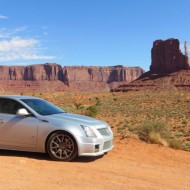
I’m writing to you today from what I believe to be the crown jewel of the entire Best Western hotel chain. By this, I mean the place has a hot tub, a restaurant that serves prime rib, a bowling alley (a bowling alley!), and wireless Internet that worked for approximately seven glorious minutes yesterday evening, provided, of course, that I operated my computer while standing in the closet. Really, it’s great. I’d leave a review, but the rating system is online.
The reason for my hotel stay is that I am currently taking my Cadillac CTS-V Wagon on a 5,500-mile roadtrip across the country and back. Some of you will remember this. For those who don’t, a little refresher: I am currently taking my Cadillac CTS-V Wagon on a 5,500-mile roadtrip across the country and back.
It’s been three days and 2,000 miles, which means it’s time to provide you, dear reader, with some updates. For more updates and photos, please follow me on Twitter, where I’m posting from the road as often as I can. (Actually, I’m dictating updates to my girlfriend, who says things like: “Do you want an exclamation point or a period?”) Anyway, here goes:
Day 1: Atlanta, Georgia to Yukon, Oklahoma
My girlfriend and I intended to start our roadtrip around 7:30, which, thanks to Roadtrip Time, meant that we actually left around 9. Roadtrip Time is a well-documented phenomenon in which, no matter how long you allow for activities, things always take considerably longer when you’re on a roadtrip. Really: you could budget 45 seconds for “peeing” only to look at your watch and realize you’ve spent 30 minutes at it, and you’re now projected to arrive at your hotel approximately nine hours late.
The first day’s drive was very long, so we broke it up with a few interesting side trips. This included the Elvis Presley Birthplace in Tupelo, Mississippi, where Elvis was born; Graceland in Memphis, Tennessee, where Elvis lived; and the city of Little Rock, Arkansas, where Elvis did nothing except maybe the occasional line of cocaine off a toilet seat. (To all of you Elvis fans out there who are now offended, I sincerely apologize for this remark. The drug was actually LSD.)
Anyway, for those of you who want to know about the car: day one was mostly uneventful. The rear seats are down because the back is full of stuff, which means I’m basically driving an enclosed El Camino. Yes, onramps are fun. No, rain is not. And to the guy in the G8 GXP who attempted to race me at 1am on I-40 in Oklahoma City: sorry, but my car was loaded down with Elvis memorabilia.
Total Distance – 898 miles
Total Fuel – 49.169 gallons
Fuel Economy – 18.26 mpg
Day 2: Yukon, Oklahoma to Kayenta, Arizona
Day two started with some excitement thanks to a low tire pressure light. I’m close friends with this light because it goes on every few weeks in my Range Rover, usually just to remind me that it is, in fact, capable of illuminating. In the Cadillac, a tire actually was low, so we filled it with a precise amount of gas station air (also known as: however much the machine spit out before it shut off) and we were back on the road.
The rest of the day was largely uneventful, though we did visit three highly important US cities: Amarillo, Texas; Albuquerque, New Mexico; and Gallup, New Mexico. I say “highly important” because these three cities are so completely devoid of anything memorable that I believe a striking enemy would simply forget to destroy them, thereby making them tactical strongholds.
OK, so it isn’t quite that bad. Amarillo, for instance, has “Cadillac Ranch,” which is an art installation where tourists come from miles around to spray paint several 1950s Cadillacs that are inexplicably sticking up from the ground. And “Old Town” Albuquerque featured charming adobe buildings and people selling items in that turquoise color that’s required on all jewelry by New Mexico state law. It also included a mariachi band, possibly celebrating “New Mexico Stereotypes Day.”
The automotive highlight: on the 192-mile stretch from Gallup, New Mexico, to Kayenta, Arizona, we somehow averaged 20.22 miles per gallon. I say “somehow” because these were mainly two-lane highways, which meant I did a lot of opposite-side passing. For those who are unfamiliar with such driving, let me just say that few experiences in life equal the sheer terror placing all of your trust in the highway department’s dotted road lines in the middle of the night.
Total Distance – 868 miles
Total Fuel – 46.805 gallons
Fuel Economy – 18.55 mpg
Day 3: Monument Valley and the Grand Canyon
Day three didn’t involve big miles (only 277) but it did include two major sights: Monument Valley and the Grand Canyon.
For those unfamiliar, Monument Valley is a large collection of enormous red buttes that tower over the desert on the Arizona/Utah state line. The Grand Canyon, meanwhile, is a large collection of foreign tourists who park crooked because they’ve rented a Ford Expedition, even though the largest vehicle they had previously driven was a Volkswagen Polo Diesel.
No, I’m kidding. There’s also a canyon there. But the real automotive highlight was taking the Cadillac down the off-road trail at Monument Valley. Here’s what happened: we were warned before entering the park that this would be a “rough” trail. But then we saw people driving Chrysler Sebring convertibles on it, which caused us to think: How bad can it be?
This was a bad idea, primarily because it turns out the famous PJ O’Rourke saying “the fastest car is a rental car” could be modified for Monument Valley purposes to instead be “all rental cars are Jeeps.” At one point, I was passed by a Nissan Sentra. However, there is a silver lining: I can now vouch for the impressive off-road capabilities of the Michelin Pilot Sport.
Total Distance – 277 miles
Total Fuel – 15.193 gallons
Fuel Economy – 18.23 mpg
So there you have it, folks: a report from our first 2,000 miles on the road. We have at least 3,500 miles left to cover (and probably more) so expect another update soon. I just have to make it to the next Best Western, where the wireless username will be “Guest,” the password will be “Guest,” and the Internet speed will be about the same as calling a friend and asking him to describe what’s on my favorite websites. I suppose it’s better than sleeping in the Cadillac.
Total Distance – 2,043 miles
Total Fuel – 111.167 gallons
Fuel Economy – 18.38 mpg
This post originally appeared on Jalopnik.
